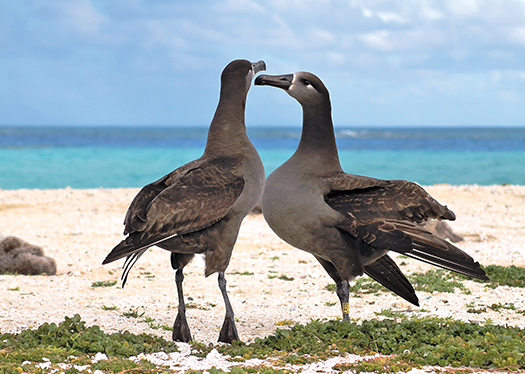
If the black-footed albatross relocation project succeeds, dances like this one in Hawaii will become common in Mexico’s Guadalupe Island Biosphere Reserve. (Photo by shutterstock.com, Mark Sully)
Imperiled by climate change, the black-footed albatross may survive thanks to a U.S.-Mexican project involving Midway Atoll in the Northwestern Hawaiian Islands chain and Mexico’s remote Guadalupe Island Biosphere Reserve in the eastern Pacific Ocean.
Under the binational project, 27 black-footed albatross (Phoebastria nigripes) eggs and chicks have been moved from Midway to Guadalupe Island, a 6,100-kilometer (3,790-mile) journey.
Project staff members were elated when a young bird from the translocated Midway stock took flight June 17 from Guadalupe Island, which is 241 kilometers (150 miles) off the western coast of the Mexican state of Baja California. By July 7, all 27 of the albatrosses that hatched from the airlifted eggs or were transported as chicks had taken wing. “This is a total success,” says Federico Méndez, general director of the Islands Ecology and Conservation Group (GECI), a Mexican nonprofit. “It was really satisfying to achieve this first step.”
Méndez says the project aims to have 100 young albatrosses fledge from Guadalupe Island in the next two years, with the surviving birds expected to return for breeding in three to five years. He expects the birds will forage north along the Pacific coast of North America. An apex predator, the albatross consumes large fish and squid, and is known to travel thousands of miles across the ocean.
Private and public partners
Méndez’s group forms part of a binational, private-public network overseeing the translocation effort, with other group members including Pacific Rim Conservation, a Hawaii-based nonprofit; Mexico’s National Commission of Natural Protected Areas (Conanp); and the U.S. Fish and Wildlife Service. Private U.S. and Mexican foundations are underwriting the albatross project, while government agencies provide in-kind support, say Méndez and Eric Vanderwerf of Pacific Rim Conservation.
The Guadalupe Island project builds on experience gained from the successful translocation of black-footed albatross eggs and chicks to the Hawaiian island of Oahu, Vanderwerf says. Midway Atoll, site of the pivotal air and sea battle between the United States and Japan during World War II, is a focal point of the effort. According to Vanderwerf, about 95% of the birds nest on Midway and other Northwestern Hawaiian Islands, including Laysan Island and Tern Island. Extending nearly 2,000 kilometers (over 1,000 miles) beyond the main Hawaiian Islands, the atolls form part of the Papahānaumokuākea Marine National Monument.
A designated Unesco World Heritage site, the monument has been identified by the U.S. Geological Survey as home to the largest concentration of tropical sea birds in the world, with an estimated 15 million birds representing 22 species. But the small, low-lying islands are vulnerable to sea-level rise, a trend that threatens black-footed albatross beach nesting sites. In 2011 nearly one-third of the albatross nests on Midway were flooded, Méndez notes. Since then, “thousands” of nests have been washed away every year, according to Vanderwerf.
The goose-sized albatross is considered “near threatened” by the International Union for Conservation of Nature (IUCN) and is listed as threatened by Mexico’s Environment and Natural Resources Secretariat (Semarnat). Vanderwerf says the last estimate pegged the bird’s global population in 2009 at 57,000 pairs. Since 2001, thirteen nations have signed an accord called the Agreement on the Conservation of Albatrosses and Petrels. Méndez says Mexico and the U.S. have not ratified the agreement but participate as observers.
A promising location
Though the black-footed albatross does not face immediate extinction, its advocates want to act now rather than wait until climate-induced flooding puts the bird in greater danger. Méndez and Vanderwerf say Guadalupe Island offers various advantages, such as higher elevations and an established colony of Laysan albatrosses (Phoebastria immutabilis) where black-footed albatross eggs can initially be hatched. They say the island’s location in the cool, upwelling waters of the California Current provides a hedge against rising ocean temperatures and resulting food-chain disruptions.
Black-footed albatrosses have been documented on Guadalupe in the past, but they disappeared following the arrival of feral cats and other invasive predators. They also were previously observed on another Mexican island—San Benedicto, which sits 370 kilometers (230 miles) south of the tip of the Baja California Peninsula. Prepping for this year’s translocation, Méndez and others worked diligently for several years to remove threats of predation. “This allowed the possibility of bringing black-footed albatrosses from Hawaii,” he says.
The presence on Guadalupe of a fishing cooperative, the Mexican Navy and Conanp—which administers the Guadalupe Island Biosphere—provides the project helping hands, boats and an airstrip. The binational partners provide the rest. Says Vanderwerf: “This has been a fantastic collaboration involving ourselves, two NGOs and two governments.”
- Kent Paterson